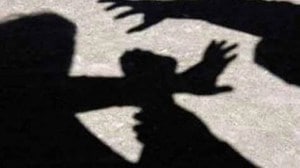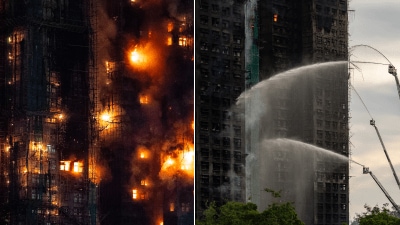Stay updated with the latest - Click here to follow us on Instagram
Mumbai rains: Trains stranded, stations crowded
“We went outside to get a cab to go home in Titwala. The private ones showed a surge price of Rs 1,900 and were not available even when we were willing to pay. So we came back to the station hoping for the trains to start,” said Nazmin Khan, a resident.
 Commuters walk along railway tracks near Parel station. Ganesh Shirsekar
Commuters walk along railway tracks near Parel station. Ganesh Shirsekar
With the lifeline of the city slowing to a crawl and then completely getting paralysed by mid-afternoon, the day’s most harrowing experiences played out in stranded trains and crowded suburban railway stations. Thousands alighted from trains and waded in knee-deep water only to find themselves without any other means of transport. Senior citizens, unable to get off the trains, and those waiting for trains to the distant suburbs spent long, frustrating hours hoping desperately to find a way to get home.
At Kurla, trains on the main and harbour lines towards CSMT began slowing down post noon. On the harbour line, due to heavy water-logging between Kurla, Chunabhatti, Guru Tegh Bahadur Nagar and Vadala Road stations, trains came to a complete halt. The situation was the same on the main line between Kurla and Sion stations. Trains were lined up one after the other, with passengers getting no information on what to expect.
“Even when I got into the train at Kurla, there was no announcement that two trains are already stuck ahead. They should have made it clear that it was not advisable to get into the train. I have a two-year old infant with me,” said Niyati Patil, a resident of Seawoods who was going to Parel. Wary about walking on the railway tracks carrying a baby, she had no choice. Patil, along with a group of women, alighted from a CSMT-bound train and walked back to Kurla station, joining thousands of stranded passengers waiting there.
“We went outside to get a cab to go home in Titwala. The private ones showed a surge price of Rs 1,900 and were not available even when we were willing to pay. So we came back to the station hoping for the trains to start,” said Nazmin Khan, a resident of Titwala, who, along with her family including her two children had left early morning for a shopping trip to Gandhi Market in King’s Circle. “There was no advisory about such extreme weather,” Khan grumbled. She waited at the station for over two hours while her relatives searched for a cab. Many passengers travelling to the central suburbs for Ganpati darshan were also stranded.
Outside Kurla station, at the bus stand, passengers ran around to board buses that stood in knee-high waters. The BEST staff kept making announcements that since most of the buses were stuck on the road and had not returned to the depot, there were fewer buses. “It took me an hour to come from Amar Mahal in Chembur to here, which is barely a 10-minute ride usually,” said one bus driver.
At Bandra-Kurla complex, many private offices arranged for buses to ferry employees. “We sat in a bus at 4.30 pm but barely covered a kilometre in an hour. We then began walking. Many locals were out on the streets guiding those stranded to the proper road, alerting them about where there were open manholes or potholes,” said Anand Iyer, who walked to his Chembur home from BKC.
Outside Bandra station, commuters waded through knee-deep water to haggle with auto-rickshaw drivers, in vain – most refused to ply in the heavy showers. A huge number of people were waiting at platforms waiting for trains to begin operations while others were stranded inside trains going towards Churchgate which had stopped at the platforms around noon.
At age 76, Harish Saha was one of the hundreds of senior citizens who waited for long hours stoically, without adequate toilets or even benches. He waited nearly four hours, since 2.30 pm, for a train. “I am retired but had come for a company meeting. I have to go back to Borivali. Some 15 to 20 years ago, on such a day when it was raining heavily I had walked from Bandra to Borivali. If need be, I’ll do it again,” he said anxiously, eating snacks from a cardboard box handed out at the meeting he had attended. At all stations and on board trains, the ineffective public address systems compounded the ordeal.
Mukesh Bajaria, 58, who was stuck in a Churchgate-bound train that could not move ahead of Elphinstone, said, “It has been almost eight hours since I took the train from Malad. The train first inched slowly between Malad and Bandra, but had then gathered pace till Dadar. Just when I thought the worst was over, the train braked at Elphinstone around 1.30 pm, and has been stationed there since. But there was no announcement on the public address system during these eight hours,” he said.
Bajaria, a businessman, who has an office in Charni Road, said, “At Elphinstone, we could not even get out on the road, as both sides of the road were completely inundated. Had some announcement been done, I’d perhaps have alighted much earlier.” Stranded at Elphinstone Road Railway station, some passengers lost their cool. Some women passengers were crying, while some of them were seen venting their frustration. A few good Samaritans walked around offering food and water to the harried commuters.
 People walk through a waterlogged train station during heavy rains in Mumbai (AP Photo)
People walk through a waterlogged train station during heavy rains in Mumbai (AP Photo)
The Mumbai deluge
What worked and what didn’t
What worked
* Agencies followed various operating procedures set out for circumstances such as these. Agencies coordinated, the NDRF was rushed in, Navy and the Coast Guard were on guard immediately, life-guards at beaches were on high-alert.
* Social media, not so all-pervasive in 2005, was used by agencies as well as residents to offer help, share information and updates. Mumbai Police, particularly, were regular on Twitter, even offering help to people who tweeted information on where they were stranded.
* Unlike 2005, the CCTV network now in place helped the Mumbai Police to monitor major spots and try and manage traffic.
What didn’t work :
* Mumbai’s famed suburban train services collapsed leading to a gridlock on the city’s arterial roads as harried commuters took to the roads to reach home. What resulted then was chaos —with many stuck in traffic for hours— reliving the experience of 2005.
* The pre-monsoon cleaning of drains, long seen as a scam-ridden and contractor-controlled operation, was not up to the mark. Hours after the rains receded, with the tide also out after 5 pm, the railway tracks remained submerged until much later. Even at 9 pm, railways could not resume services. Whether the railway’s pre-monsoon nullah-cleaning was done adequately will have to be checked.
* Calm, sensible and properly thought out advisories to residents were missing. There were no messages in the morning hours although the IMD had predicted very heavy rains. By mid-morning, long after residents were already stuck in trains and traffic, agencies and politicians began tweeting, requesting people not to venture out.
* Railway PA systems did not offer information on how many trains are bunched up ahead of a station. People boarded trains only to regret it for hours subsequently.







